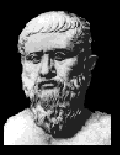| Connections 3 : Greek Philosophy |
|
www link : From the Internet Encyclopedia of Philosophy : Description of: Sophists |
|
The Sophists
Teachers of wisdom , the sophists, had been training young Athenians in the art of arguing. Speaking well was a necessity for a political career in a democracy, since nothing of importance could be done without first persuading the Assembly of the citizens. As the sophists began to think about speech, they soon discovered that language and argument had rules which could be analyzed. Mastery of the rules of logic prepared them to show how to argue for or against any opinion, regardless of moral considerations. |
|
Socrates 469-399 B.C.
To us such a view seems remote from reality but the close connection between virtue and knowledge is characteristic of Greek thought.
But the Socratic method - this close questioning and answering, not letting any assumption go unchallenged - was crucial for
later scientic investigations. One characteristic that distinguishes science from our day-to-day thinking is the requirement for internal consistency. Under close examination many of our common-sense ideas turn out to be contradictionary. One cannot be like that in science. The fact is that the Socratic method really questions what our assumptions are. If we look closely at everything, do any of two assumptions contradict each other? |
|
www link : From the Internet Encyclopedia of Philosophy Symposium A conversational drinking party with sophisticated guests. Socrates from the Biography Center. The Death of Socrates by Plato |
Plato 427-347 B.C.
 Plato moved from the Socratic search of ethical definitions to the theory of ideas. He divided the cosmos into two separate regions: the world of being , and the world of becoming . The former he regarded as perfect, unchanging, the essence of what he called Ideas . All those concepts sought by Socrates - justice, virtue, etc - existed in perfection in the world of Ideas. To Plato, the world of Ideas was the real world; the material world, though seeming real to our senses, was only an illusion. Plato used his famous 'Allegory of the Cave' to make the distinction between illusion and reality. (See www link below).
For example, to tune a muscical instrument, a player adjusts his strings according
to arithmetical ratios that define particular notes. These arithmetical relations
express harmonic intervals, and never get out of tune. The harmonic relations
cannot be heard, but are understood by the mind. The best preparation, Plato thought, was training in mathematics: the geometer considers not the ill-defined drawing, but the perfect, ideal triangle which truly exists in the world of Ideas. Plato was the first to suggest the desirability of finding a geometrical model for the physical universe. |
|
www link : From the Internet Encyclopedia of Philosophy Biography and Greek Philosophy
Allegory of the Cave from 'The Republic'
|
| Back | Next: Science |
 One of the Athenians who was most shocked by
the sophists was Socrates, who devoted his life to
the pursuit of truth. He was more interested wether
an arguments conclusion was true than wether it was
convincing and he used the sophists tools of logical
analysis to investigate the nature of virtue.
He thought the search for knowledge of the utmost
importance because he maintained that no man sins
wittingly - from which follows, that whoever knows
what is good does what is right.
One of the Athenians who was most shocked by
the sophists was Socrates, who devoted his life to
the pursuit of truth. He was more interested wether
an arguments conclusion was true than wether it was
convincing and he used the sophists tools of logical
analysis to investigate the nature of virtue.
He thought the search for knowledge of the utmost
importance because he maintained that no man sins
wittingly - from which follows, that whoever knows
what is good does what is right.